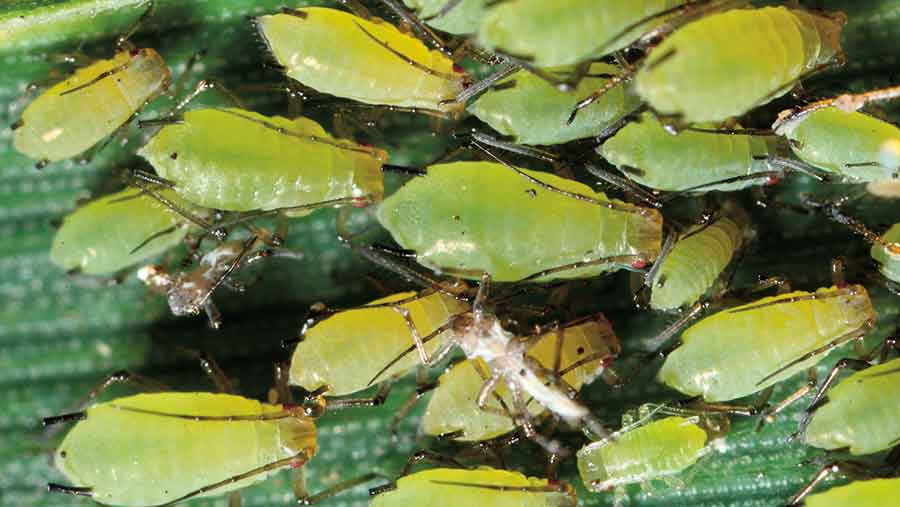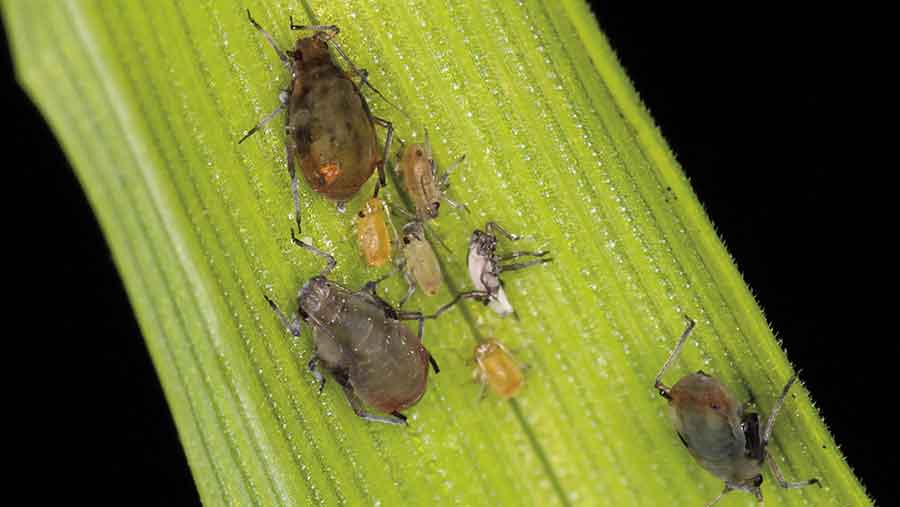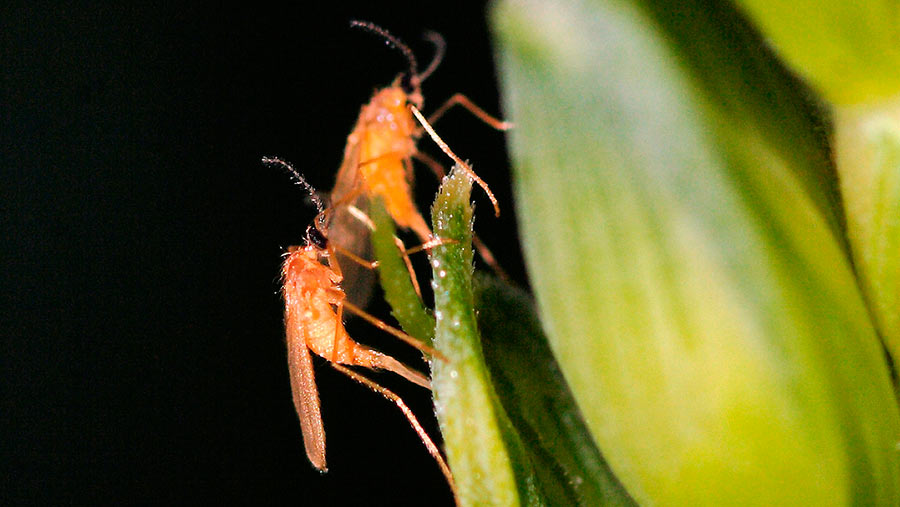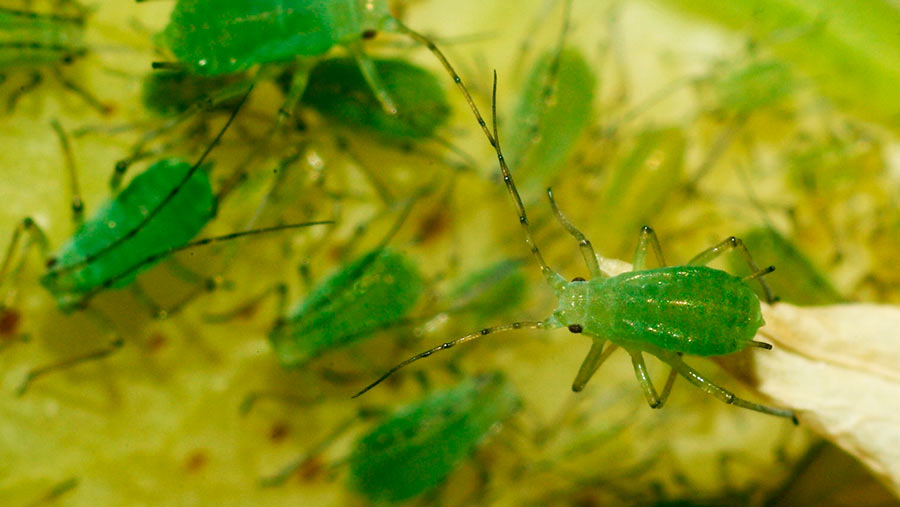Aphid threat looms as winged pests fly into crops
Aphids are invading cereal crops rapidly and growers are being urged to monitor fields as wheat and barley ears start to emerge – and to treat only if absolutely necessary.
The migration of aphids into cereals and other crops is coming earlier and more strongly than usual after a mild winter, with agronomists reporting that the winged insects are on the move.
Although aphids can cut grain yields and carry disease, experts are warning against any knee-jerk reaction to spray and they advise waiting for ear emergence.
Independent entomologist Alan Dewar cautions that most wheat crops are not near to heading and there is rarely a benefit from spraying for aphids before this stage.
See also: Branded parallel pesticides ‘could cause confusion’
“The message is don’t panic, but start to monitor crops and spray only if you really need to,” he tells Farmers Weekly.
Dr Dewar adds that as aphids settle in crops they will encourage natural predators, which could help save the cost of a pesticide.
Three key species

Grain aphids © Blackthorn Arable
In addition, in eastern England one key species – the grain aphid – is now 50% resistant to the only recommended insecticide treatment – pyrethroids.
Three main aphids can cause damage to cereal crops – grain, bird cherry-oat and rose-grain. The first attacks the ear and the other two tend to feed on the leaves.
The grain aphid feeds directly on honeydew within the grain and this can lead to secondary infection of sooty moulds, cutting yield and quality.
Most damage in wheat occurs when grain aphids colonise ears from the start of flowering (GS61), usually in mid-June, to the milky ripe grain stage (GS73).
Mark Taylor, entomologist at Rothamsted Research, says aphids have survived the winter well, and from the centre’s nationwide aphid traps he is seeing that the migration has started earlier and is stronger than in previous years.
Numbers are high for the grain and bird cherry-oat aphids, the two main species that carry barley yellow dwarf virus (BYDV), and although winter cereals are past the risk period there could be a threat to backward spring barley crops.
“Aphids are flying with the slowly warming season but if the weather really starts to warm up then numbers will really begin to increase,” he says.
Resistance problems

Bird cherry-oat aphids © Blackthorn Arable
Steve Foster, also from Rothamsted, says growers are facing problems from pesticide resistance and with legislation withdrawing some products.
“Growers need to ensure that they are spraying at the recommended rate with pyrethroids, as a second spray is unlikely to be worthwhile,” he says.
Agronomist Martyn Cox reports low to moderate levels of aphids in north Cambridgeshire, west Suffolk and south Norfolk, but where there are patches of BYDV, he has seen big grain aphid colonies, indicating a risk for later in the season.
It is hoped that natural predators will help suppress numbers, but with the earlier and greater migration this season, a treatment could be required if aphids colonise and multiply in crops.
Dr Dewar says growers need to stick to thresholds to avoid unnecessary treatments, with a spray required only if half of a crop’s tillers are infested before the start of flowering.
If 66% of tillers are infested and numbers are increasing for the period from flowering to the watery ripe grain stage, a treatment would be economically justified.
Midge threat

Orange wheat blossom midges © Blackthorn Arable
Another pest threat could come from the orange wheat blossom midge at ear emergence, with crops at risk if the weather is wet and warm. Steve Ellis, entomologist at crop consultancy Adas, suggests setting up pheromone traps.
“Where more than 120 midges are caught per day in a trap, treatment is certainly advised in surrounding fields at ear emergence,” says Dr Ellis.
The banning of chlorpyrifos means that the range of pesticide options is restricted to thiacloprid or the pyrethroids, though some wheat varieties – such as Skyfall and Leeds – are resistant to the pest.
Oilseed rape virus

Peach-potato aphid © Design Pics Inc/Rex/Shutterstock
Sacha White, also from Adas, says high aphid numbers will bring an increased threat of turnip yellows virus (TuYV) in oilseed rape.
He points out that the peach-potato aphid, which is the main carrier of the virus, is highly resistant to products approved for its control.
“Unfortunately peach-potato aphids are almost entirely resistant to both primicarb and pyrethroid products,” he says. “Growers will have to rely on natural enemies such as ladybirds to control the higher-than-average aphid population.”
Dr White adds that he does not recommend spraying oilseed rape specifically for peach-potato aphids, as this will do little to curb the pest and may kill off its enemies.
Aphids in pulses

Pea aphids © Blackthorn Arable
Meanwhile, large numbers of pea aphids are being reported in pulse crops. Becky Ward, technical officer at the Processors and Growers Research Organisation (PGRO), says pea and bean growers may need to spray earlier than normal.
She predicts that aphid colonies will grow in the coming days as temperatures are set to hit about 20C in some parts of the country.
“The forecast is for temperatures to rise after this weekend and aphid colonies will build up in temperatures of 18C and above. This means growers should be prepared to spray earlier than they perhaps would do normally to prevent viruses taking effect.”
She says the aphid pressure has been made worse this year because some pulse crops were drilled late and are slightly behind in terms of growth.
This means any virus infection could have a bigger impact on pulse crops because the virus will have longer to affect the plant growth.
Aphids can be controlled in peas and beans with a single spray of primicarb, which is restricted to a single treatment at a maximum rate of 280g/ha.
For combining and vining peas, there are approvals for the use of thiacloprid products, including Biscaya, Pintail and Scabiya. These can be applied twice at 0.4 litres/ha but need to be applied at least seven days before the crop is harvested.
Since pressure is likely to be high this season, a single application of any product may not be enough to control virus transmission and feeding damage, meaning growers might need to consider using a sequence of products to protect crops.

